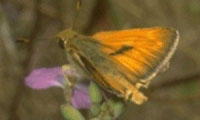Native Plants
Search for native plants by scientific name, common name or family. If you are not sure what you are looking for, try the Combination Search or our Recommended Species lists.
Phragmites australis
Phragmites australis (Cav.) Trin. ex Steud.
Common Reed, Phragmites
Poaceae (Grass Family)
Synonym(s): Phragmites australis var. berlandieri, Phragmites communis, Phragmites communis ssp. berlandieri, Phragmites communis var. berlandieri, Phragmites phragmites
USDA Symbol: PHAU7
USDA Native Status: L48 (N), HI (I), PR (N), CAN (N)
Common reed or pragmites is a tall, robust, perennial grass commonly growing up to 13 ft. in height. Stiff, wide leaves and a big, plumy inflorescence characterize this colony-forming plant which spreads by stout rhizomes. The inflorescence is purple in flower, gray in fruit.
This tall and striking plant rarely produces seed but spreads vigorously by underground stems (rhizomes), often running over the surface of the ground for 17-34' (5.1-10.2 m). It can form dense stands that exclude all other wetland species. It is the dominant vegetation of the still extant Hackensack Meadows of New Jersey where it filters pollutants from the greater New York-New Jersey metropolitan area. While this role may appear beneficial, it has no doubt out competed the native vegetation that would ordinarily serve this purpose. In New England, tidal gates across estuaries have restricted tidal flow and created heavily brackish conditions on tidal marshes, with the result that Common Reed has replaced extensive areas of tidal marsh grasses. It was formerly known as P. communis.
Plant Characteristics
Duration: PerennialHabit: Grass/Grass-like
Root Type: Fibrous
Leaf Arrangement: Alternate
Leaf Complexity: Simple
Leaf Venation: Parallel
Inflorescence: Panicle
Fruit Type: Caryopsis
Size Notes: Up to about 13 feet tall.
Leaf: Green
Bloom Information
Bloom Color: White , PurpleBloom Time: Jun , Jul , Aug
Distribution
USA: AL , AZ , CA , CO , CT , DC , DE , FL , GA , IA , ID , IL , IN , KS , KY , LA , MA , MD , ME , MI , MN , MO , MS , MT , NC , ND , NE , NH , NJ , NM , NV , NY , OH , OK , OR , PA , RI , SC , SD , TN , TX , UT , VA , VT , WA , WI , WV , WYCanada: AB , BC , MB , NB , NL , NS , NT , ON , PE , QC , SK , YT
Native Distribution: E. Que. to B.C., s. to VA, KY, LA & AZ; also scattered localities in the Southeast
Native Habitat: Fresh to alkaline marshes; pond margins; ditches
Growing Conditions
Water Use: MediumLight Requirement: Sun
Soil Moisture: Moist , Wet
CaCO3 Tolerance: Medium
Aquatic: yes
Soil Description: Wet soil to standing water; adapts to less moisture.
Conditions Comments: This is a common and sometimes unpopular grass because it can be very invasive in wet, disturbed areas. It is resistant to all kinds of disturbance itself, often coming back more vigorously if cut or burned. It is less invasive and grows to a reduced height in average garden moisture.
Benefit
Use Wildlife: Provides good cover for wetland wildlife species.Conspicuous Flowers: yes
Butterflies and Moths of North America (BAMONA)
|
Yuma Skipper (Ochlodes yuma)  Larval Host |
Propagation
Description: Phragmites can be grown from seed although germination is low.Seed Collection: Store dry.
Commercially Avail: yes
National Wetland Indicator Status
| Region: | AGCP | AK | AW | CB | EMP | GP | HI | MW | NCNE | WMVE |
| Status: | FACW | FACW | FACW | FACW | FACW | OBL | FACW | FACW | FACW |
Bibliography
Bibref 1186 - Field Guide to Moths of Eastern North America (2005) Covell, C.V., Jr.Bibref 1185 - Field Guide to Western Butterflies (Peterson Field Guides) (1999) Opler, P.A. and A.B. Wright
Search More Titles in Bibliography
Additional resources
USDA: Find Phragmites australis in USDA PlantsFNA: Find Phragmites australis in the Flora of North America (if available)
Google: Search Google for Phragmites australis
Metadata
Record Modified: 2021-03-19Research By: TWC Staff